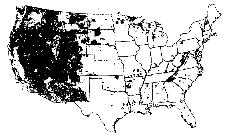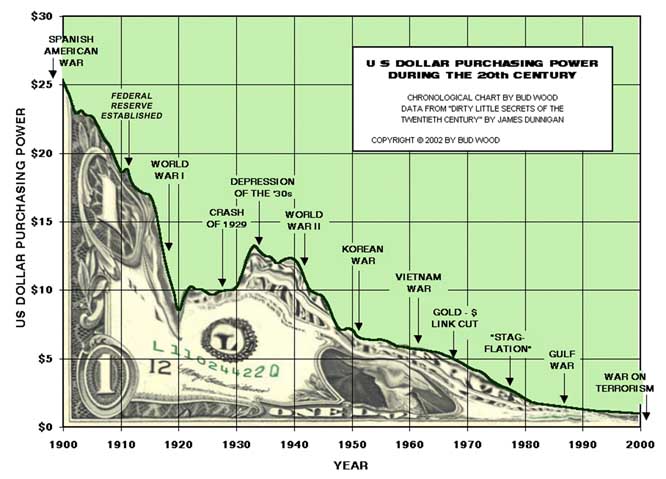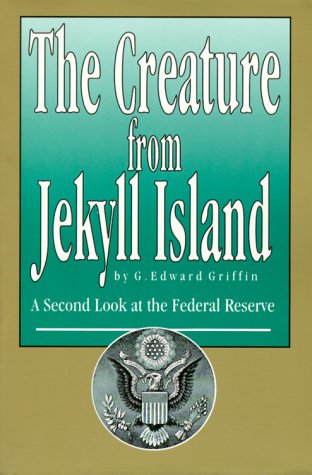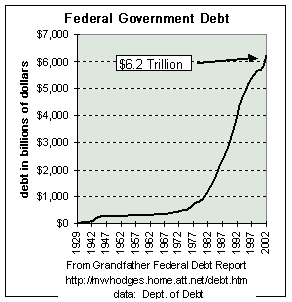 Imagine
for a moment that someone inherits a farm. Let's say that the farm has good
topsoil, a good well, good breeding stock, good seed, and excellent farm
equipment in good repair. Prior to passing into the control of the present
owner the farm did a good business selling vegetables, meat, and dairy
products to the local market, and it made a small profit.
Imagine
for a moment that someone inherits a farm. Let's say that the farm has good
topsoil, a good well, good breeding stock, good seed, and excellent farm
equipment in good repair. Prior to passing into the control of the present
owner the farm did a good business selling vegetables, meat, and dairy
products to the local market, and it made a small profit.
But let us suppose for a moment that the present owner of the farm doesn't understand farming, or isn't even really interested in learning. The present owner has no objection to standing around looking good, so he stays at the farm, standing in front of it, looking good to passers by.
Of course, the bills still come in, so our farmer puts them on his credit card. When that bill comes due he uses another credit card, Then another. Pretty soon the interest payments alone are higher than his bills and the banks get nervous and call him. No problem. Our farmer sells the tractor, takes the money around to the various credit cards, the food store, the utilities, and pays off all his bills. Then he stands around in front of the farm looking good to passers-by, the lord of his domain.
Will, the bills still come in. Again the credit cards get loaded up. So, this time our farmer sells the harvester. Then later on, the cattle, then the chickens, then the seeds, then he leases the well to his neighbor and finally sells the top soil from his farm to another farm down the road whose soil is getting tired. The cash is taken around to the various creditors, the food store, the utilities, etc.
Now at this point, our farmer thinks everything is okay. The bills are paid, he has a little cash in his pocket, and everything is fine.
Of course, you know better. The farm simply does not exist any more; it's just an empty lot with a few buildings, and soon they will be gone as well. The path from the farmer's present condition to seizure of the property for unpaid taxes is a foregone conclusion, even if the farmer doesn't look far enough ahead to see it.
Poor, dumb, stupid farmer.
That farmer is our government, and our business leaders.
Just as our hypothetical farm has lost its soil, livestock, seed, and farm equipment, America has lost its manufacturing ability. Short sighted business leaders, with as little interest in manufacturing as our farmer had in farming, decided their own personal bonuses would be higher if they simply sold their factories rather that ran them. After WW2, the 27 American TV companies including Zenith, Emerson, RCA, GE, etc. led the world in TV technology. Then, the owners of the patents on TV technology decided they didn't need to dirty their hands by actually making the TV sets themselves any more, and they started selling licenses to manufacture, which the Japanese bought.
By 1987, the only remaining American TV company is Zenith. The patent holders get their money, but the American products which can be sold overseas are gone, along with the jobs to make them.
The same happened in high-tech electronics. The integrated circuit was invented in the United States. But rather than focus on selling integrated circuits, the companies that owned that technology sold the machines to MAKE integrated circuits around the world, and now America sells very few chips anywhere. The patent holders have their money, but the cash flow from sales of manufactured goods, and the jobs that go with them, are gone. When Seymour Cray needed custom chips for his supercomputers, he had to order them from Japan.
The same thing has been happening in aviation. The airplane was invented in the United States, and through the 60s, we sold a lot of them around the world. But lately, all aircraft sales to foreign countries involve "offsets", a portion of the core technology that gets licensed to the purchasing nation and gets manufactured there. Bit by bit, the core technology gets bled off, taking with it jobs, and cash flow from the sale of those manufactured products. Along the way, the rights to manufacture American inventions outside America leak away on a steadily increasing basis. Even the mighty F-16 is now being manufactured overseas, under license.
To cover the loss of manufacturing jobs, our government has invented the catch phrase "service economy". This is the idiotic notion that we don't need to actually sell manufactured products; that we can grow and prosper our nation by doing each other's laundry. To conceal the loss of manufacturing jobs, the government has legislated into existence thousands upon thousands of useless paper-shuffling jobs, and declared their necessity by fiat. The most obvious is the income tax which has been so obfuscated by the government that half of you had to rely on an outside expert to figure out just what all those incomprehensible words really meant. By this device, the government has replaced those jobs that made products to sell with an equal number of jobs that produce nothing whatsoever of any worth, except to keep the unemployment figures down. This over-burdening of the American people with gratuitous regulations and paperwork has accomplished nothing except to obfuscate the loss of manufacturing jobs, and to transform the American character from innovators and inventors creating new products to that of minor clerks, peeking under each other's seat cushions for lost change.
So, with most of our manufacturing now gone, just what DOES America make? Trouble, mostly. With 4% of the world's population and 18% of the economy, we have 50% of all the lawyers, all looking to make a killing by looting those few industries that still call America home (like Microsoft). Kids don't want to be scientists and engineers; they've seen how little such people are valued in our country. Based on recent history, kids see the "big bucks" are in corporate law, specifically investment banking, leveraged buyouts, greenmail, junk bonds, in short what other countries describe as "trying to make money grow by shaking it side to side".
With America's ability to actually produce products that can compete on the open world market in decline, it's no wonder that the balance of trade is the problem it is. Nobody buys our export products because we just don't make that many any more, and like or not, we have to buy our appliances from the people who make them, which are NOT Americans. (When Ampex invented the VCR, they didn't even bother trying to find an American company to make it, they immediately sold the rights to Japan).
So, what do all these countries on the plus side of the trade imbalance do with their surplus billions? Well, they have been loaning it right back to us!
Our government engages in a practice politely called "deficit spending". Other terms which would aptly describe the practice include "counterfeiting" and "check kiting", but it all comes down to the same thing; spending money one does not actually have.
What would be a Jailable offense for a normal citizen was rendered legal for the government by the Federal Reserve Act. This was not a popular piece of legislation. In fact the Democrats had campaigned in 1912 on a platform of rejection of the creation of a private bank in charge of a fiat money system. Nevertheless, on December 23, 1913, taking advantage of the absence of congressmen opposed to the creation of a fiat monetary system during the Christmas break, the Federal Reserve Act was passed.
Years later, during the great depression, Congressman Louis T. McFadden (who served twelve years as Chairman of the Committee on Banking and Currency) asked for congressional investigations of criminal conspiracy to establish the privately owned 'Federal Reserve System'. He requested impeachment of Federal officers who had violated oaths of office both in establishing and directing the Federal Reserve -- imploring Congress to investigate an incredible scope of overt criminal acts by the Federal Reserve Board and Federal Reserve Banks. McFadden even suggested that the Federal Reserve deliberately triggered the great stock market crash of 1929, in order to eventually force the passage of the Emergency Banking Act of March 9, 1933, which suspended the gold standard.
In describing the FED, McFadden remarked in the Congressional Record, House pages 1295 and 1296 on June 10, 1932:
"Mr. Chairman, we have in this country one of the most corrupt institutions the world has ever known. I refer to the Federal Reserve Board and the Federal reserve banks. The Federal Reserve Board, a Government Board, has cheated the Government of the United States and he people of the United States out of enough money to pay the national debt. The depredations and the iniquities of the Federal Reserve Board and the Federal reserve banks acting together have cost this country enough money to pay the national debt several times over. This evil institution has impoverished and ruined the people of the United States; has bankrupted itself, and has practically bankrupted our Government. It has done this through the misadministration of that law by which the Federal Reserve Board, and through the corrupt practices of the moneyed vultures who control it".
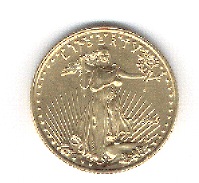
Why all the fuss over the gold standard?
Well it goes back to the original Founding Fathers and the meaning of the word "dollar". "Dollar" is actually a weight measure of silver, 371.25 grains, to be exact. Our American silver dollars are actually heavier, since other metals were added for durability. But that 371.25 grains of silver WAS the dollar, matching in weight an unbroken chain of accepted monetary units that reached back through the Spanish Milled Dollar, the Dutch Dollar, back to the German Thaler; the product of a silver mine which sold it's product in coins of an exact weight. The Coinage Act of 1792 defined our dollar to exactly match in weight the silver dollars in use around the world, and then defined the gold dollar to be that amount of gold which would equal the worth of silver in a silver dollar, 24.75 grains, 1/15 the weight of the silver in a silver dollar.
So, what's wrong with this? Nothing really. When you, as a citizen, hold a silver dollar or a gold dollar in our hand, you hold that actual worth of metal. Nothing the government can do can change the worth of the money in your control.
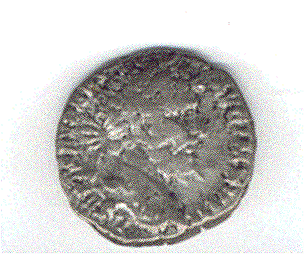
Take the Roman Silver Denarius pictured above. The Roman Empire is long gone, but the money that Rome issued still has worth because the coins themselves had inherent worth. Long after the collapse of the empire, Roman silver coins were still used as money, because the silver in the coin itself did not depend on the issuing government for its worth.
Of course, carrying around too much coin can be bothersome, so many nation, including our own, issued paper notes as a convenience. But that paper currency of the nation was just a convenience. The gold and silver certificates were merely "claim checks" for the equivalent weight of gold or silver held in the treasury, and which would be produced on demand when the certificate was presented. But in the end, the lawful dollar of the United States was 371.25 in silver, or 24.75 grains of gold.
The problem with this system from the point of view of the government or the banks is that it limits the amount of money they can work with. When the bank runs out of silver or gold (or the equivalent certificates) it can no longer lend any more money with which to earn interest. When the government runs out of gold or silver (or the equivalent certificates) it can no longer spend money (just like the rest of us).
The immediate effect of ending the gold standard was that with the paper dollar no longer legally dependent on 371.25 in silver or 24.75 grains of gold, more paper dollars (now called "Federal Reserve Notes") could be printed, their worth no longer under the control of the citizens but under the control of the issuing central bank, based on the total number of dollars printed (or created as credit lines). The more dollars which are created out of thin air, the less each one is worth.
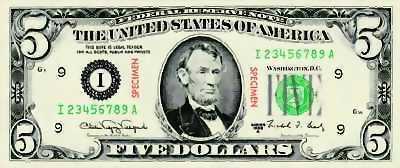
A federal Reserve Note.
The swindle of the system is simple. The Federal Reserve Bank hires the US Treasury to print up some money. The Federal Reserve only actually pays the treasury for the cost of the printing, they do NOT pay $1 for each 1$ printed. But the Federal Reserve turns around and loans out that money (or credit line) to banks at full face value, those banks which have exhausted their deposits then loan that Federal Reserve fiat money to you, and you must repay it in the full dollar value (plus interest) in work product, even though the Federal Reserve printed that money for pennies, or created it out of thin air in a computer.
As the Federal Reserve overprints more money, the money supply inflates, and too much money starts chasing too few goods and services, which means prices go up. But contrary to the charade put on by the Federal Reserve, inflation doesn't just come and go due to some arcane sorcery. The Federal Reserve can halt inflation any time it wants to by simply shutting down those printing presses. It therefore follows that both inflation and recession are fully under the control of the Federal Reserve.
Over time, that excess of printing has destroyed the value of that dollar you think you have. If you want to know by just how much, go out and try to purchase 371.25 in silver right now. Usually, the deterioration is gradual. Sometimes, it has to be obvious, such as the 1985 devaluation (done to halt the trade imbalance) which triggered the Japanese real-estate grab in this country.
Many politicians have attempted to reverse this process. John F. Kennedy issued an Executive Order 11110, requiring the Treasury Department to start printing and issuing silver certificates for the silver then remaining in the US Treasury.
Kennedy decided that by returning to the constitution, which states that only Congress shall coin and regulate money, the soaring national debt could be reduced by not paying interest to the bankers of the Federal Reserve System, who print paper money then loan it to the government at interest. This was the reason he signed Executive Order 11110 which called for the issuance of $4,292,893,815 in United States Notes through the U.S. Treasury rather than the traditional Federal Reserve System.
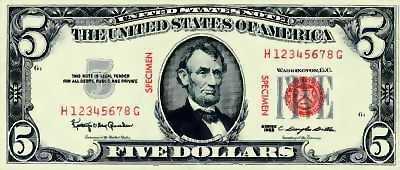
John F. Kennedy's United States Note.
That same day, Kennedy signed a bill changing the backing of one and two dollar bills from silver to gold, adding strength to the weakened U.S. currency.
Kennedy's comptroller of the currency, James J. Saxon, had been at odds with the powerful Federal Reserve Board for some time, encouraging broader investment and lending powers for banks that were not part of the Federal Reserve system. Saxon also had decided that non-Reserve banks could underwrite state and local general obligation bonds, again weakening the dominant Federal Reserve banks".
Kennedy's executive order was never implemented following his assassination, and shortly afterwards, United States silver coins were taken out of circulation and replaced with the copper clad slugs in use today. These two events, the failure to print new silver certificates, and the substitution of worthless slugs for our silver coins, may explain why the Warren Commission included on its panel John J. McCloy, a man with no experience in crime, law enforcement, or national security, but who had been the President of the Chase Manhattan Bank.
It should be noted that the banks themselves are still using the gold standard. Accounts are still settled between major national banks by the transfer of gold bullion.
So here we are with a bank that legally counterfeits the money you borrow but expects a full value (plus interest) repayment. But what's good for the Federal Reserve is good for the government itself, and this is where we get back into that funny word "deficit spending". The government spends more money than it takes in. It has for many years now. The Federal Reserve, being the only lawful source of this fiat money, prints up the excess cash the government needs (or manufactures a credit line in a computer). This extra cash is treated as a loan, in order to keep the government overspending from further eroding the worth of the dollar in the world market. The government (meaning the taxpayers) is on the hook for the full face value, plus interest.
But there's another problem. The government is borrowing so much money that it drives the interest rates up! You pay MORE interest on your mortgage, car loan, and credit cards, because the government cannot balance its books. That extra interest you pay is therefore another hidden tax. The government, in its "generosity", gives you a tax credit on mortgage interest that is higher because of their own borrowing!
During the 80s, as exports dropped, and jobs moved from manufacturing to lower paying "service sector" jobs, the US tax base declined. In order to keep the jobless rate from rising, a massive defense program called the Strategic Defense Initiative was cranked up, but since this program produced no exportable product, it produced no taxable sales revenues, and hence the money poured into the project accelerated the government decline into debt. Because manufacturing was on the decline, fewer start-up companies were approaching the lending institutions, so the government loosened up the rules (while increasing the insurable deposit limit) to allow "investments" in more high risk ventures, most of which turned out to be frauds, or worse, money laundering operations for drug criminals. This includes Whitewater, Flowerwood, and Castle Grande. Despite shifting the S&L loss primarily onto the taxpayers (to reassure foreign investors that the taxpayers still made America a safe place to park their surplus cash) the government plunged further into debt.
In the 12 years of the Reagan/Bush administrations, the United States went from being the world's largest creditor nation to the world's largest debtor. Many of those nations which had enjoyed huge trade surpluses started loaning that profit back to the United States with the stipulation that we work on our manufacturing, clean up our infrastructure, raise taxes, in short, clean up our act, so that investment in America makes sense!
However, we didn't quite do that.
There has been some shuffling around to try to conceal the real scope of the problem. Over the last several years, the Federal Government has been sending less tax money back to the states than it takes in in taxes. This means that the states have to borrow MORE money to cover their obligations. The net result is that the debt is being transferred to the states, to conceal its true size. The government will easily admit to a $3 trillion "publicly held" debt, grudgingly concede that it's "unfunded liability" brings that number to almost $7 trillion, but the real hard truth is that total government debt, state and federal, is now over $14 trillion dollars, or about 50,000 for every man, woman, and child inside the United States. Since 1960, the taxpayers have shelled out $15 trillion in interest payments alone, while the principal continues to rise.
Yet another stunt the government has pulled is to "borrow" from the various trust funds under its control. Some $2 billion has vanished from the trust accounts of Native Americans (presently suing the Departments of the Interior and Treasury), and nearly ¾ of a TRILLION dollars has been removed from your Social Security retirement trust fund and spent in the last 8 years.
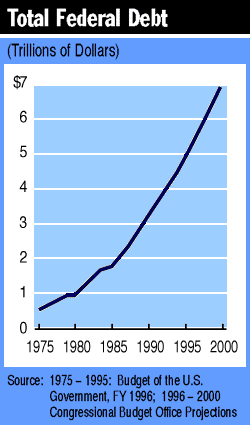
If the government has to borrow your retirement money when things are supposed to be so good, under what conditions can it repay the money? Or is that government IOU in your retirement account merely a promise to either tax you a second time or stiff you on the benefits you thought you were paying for?
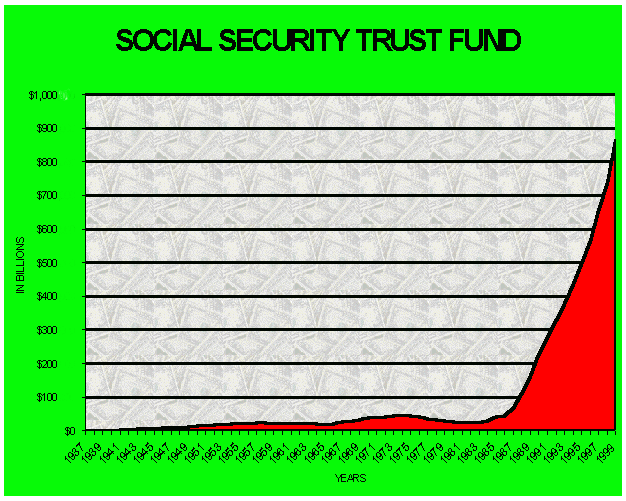
In the last 8 years, during what are supposed to be record setting good times, the Federal government has nearly DOUBLED its debt load. The estimated interest on the debt equals all the personal income tax paid by all Americans. Our government is so deep in debt that it cannot get out.
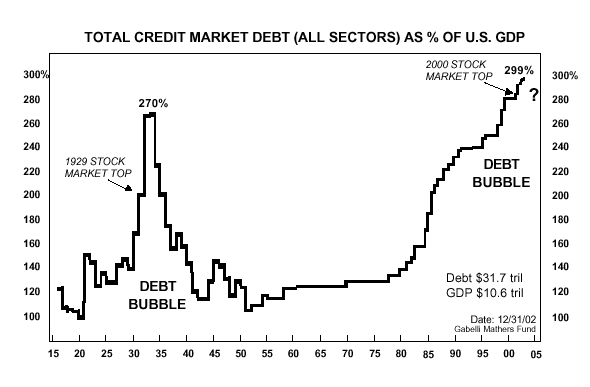
This brings us to the issue of collateral. We've borrowed so much money the lenders are getting nervous. Back during the Johnson administration Charles DeGaulle demanded the United States collateralize the loans owed to France in gold and started carting out the bullion from the treasury. This caused several other nations to demand the same and President Nixon had to slam the gold window closed or the treasury would have been emptied, since the United States was even then in debt for more money than the treasury could cover in gold.
But Nixon had to collateralize that debt somehow, and he hit upon the plan of quietly setting aside huge tracts of American land with their mineral rights in reserve to cover the outstanding debts. But since the American people were already angered over the war in Vietnam, Nixon couldn't very well admit that he was apportioning off chunks of the United States to the holders of foreign debt. So, Nixon invented the Environmental Protection Agency and passed draconian environmental laws which served to grab land with vast natural resources away from the owners and lock it away, and even more, prove to the holders of the foreign debt that US citizens were not drilling. mining, or otherwise developing those resources. From that day to this, as the government sinks deeper into debt, the government grabs more and more land, declares it a wilderness or "roadless area" or "heritage river" or "wetlands" or any one of over a dozen other such obfuscated labels, but in the end the result is the same. We The People may not use the land, in many cases are not even allowed to enter the land.
This is not about conservation, it is about collateral. YOUR land is being stolen by the government and used to secure loans the government really had no business taking out in the first place. Given that the government cannot get out of debt, and is collateralizing more and more land to avoid foreclosure, the day is not long off when the people of the United States will one day wake up and discover they are no longer citizens, but tenants.
The following map shows the current extent of all lands grabbed by the government under the guise of environmentalism.
In short, the United States is in deep trouble. We have lost a huge amount of our manufacturing capacity, and those products we still make do not compete well on the world market, despite the steady devaluation of the dollar. In short we have vast debts to pay and little to pay them with. Like the foolish Farmer we have sold the machinery that allowed us to prosper, and we stand around shaking our investment portfolios back and forth in the hopes that the money inside will somehow grow all by itself. It won't. It never has. The very best that can be said is that money gets moved from one person to the other.
Those nations and banks to whom we owe money have been very patient indeed with us. They know that our economies are so tightly entwined that what hurts America will hurt them. But sooner or later, possibly after a market crash, someone, in order to pay their own debts, will demand their loans to the United States be paid. Rather than get caught with "bad paper", there will be a run on the United States government.
In addition to the government debt of $14 trillion, our businesses are home to trillions more in foreign investment, kept here by the promise that the American taxpayer will be made to cover all losses. But with our manufacturing in decline and our schools producing far more lawyers than anything else, it should be obvious to the prudent observer that the American taxpayer, even if so inclined, may not be able to cover the losses of their own government, let alone a foreign investor. That has to be making them nervous as well.
This brings us to the "equities markets", most notably the stock market. Over the last several years a constant media harangue has assured us that the soaring numbers of the stock market are the sole measure of how good our economy is. But close examination of those high-priced stocks reveals that most are heavily over-valued; their price the result of market forces rather than underlying worth (earnings ability). Amazon.com, as one example, has had a terrific run-up of its stock price, even though the company itself has yet to show a profit.
The government has admitted to using covert means to prevent a market downturn; to keep the stock prices at an artificially high and overvalued level, in order to wave those impressive numbers about as "proof" that everything is okay so that the taxpayers go back to work and pay more taxes. But in order to keep those stock prices up above their actual worth, demand must be maintained to keep the prices high. In other words, NEW investors must constantly be brought into the bottom of the pyramid to keep the prices of the stocks at the top from dropping. Hence the onslaught of commercials luring neophyte investors into the stock market via "online trading". Like any Ponzi scheme, the stock market will collapse when no more new buyers can be dragged in at the bottom. As the market starts to stutter, governments (most recently Britain) have moved to dump huge reserves of gold onto the world market to depress gold prices and deter investors from deserting the stock market for gold.
Some years back I worked on the film version of "The Day The Bubble Burst", and in between playing a stock broker, I got to spend some time with the show's consultant, Mr. William Hupt, who had been on the trading floor in 1929 as it all fell apart. He still had, framed, that last strip of ticker tape that ushered in the Great Depression, and he shared some stories which have a bearing on what is going on today.
The first story Bill shared is that there had been early indications of a dangerously over-valued market, running to deep on margin, and like the Plunge Protection Team, the largest investment houses, in particular the House of Morgan, attempted to reverse the early corrections by purchasing large blocks of stock in order to create market demand and drive the prices back up. It worked all but the last time.
The second story Bill shared was that a friend of his, riding up to his office in September of 1929, overheard the elevator operator chatting about his own stock portfolio, and his investments. Something about that image of an elevator operator playing the market set of warning signals, and Bill's friend immediately liquidated his entire portfolio, just in time to miss the great crash. Many people, including the actor Charlie Chaplin, had recognized the "recruitment" of that segment of society that did NOT have risk capital as new investors as a desperate attempt to prop up an overvalued market, and got out in time to save their own personal fortunes.
In the end, there is no such thing as a free lunch. You cannot make money grow in value by shaking it back and forth from one bank to another. You cannot prosper a nation by doing each other's laundry, or filling out their government mandated and greatly obfuscated paperwork, or flinging stock certificates around which may have as little real worth as Federal Reserve Notes. To make money, to show a profit, you must make products that somebody else wants to buy, and sadly, that is a capability the United States has allowed to slip away in great measure. The "service economy" was political propaganda to make the public believe that the decline of our manufacturing ability was a good thing.
Our nation is broke, bankrupt, and having sold much of its machinery and technology (or given it away to political donors), is unable to easily return to those endeavors which once made our nation great. Our infrastructure is in decay (the percentage of roads in the US with major damage doubled last year alone), our public schools unable to produce a workforce able to function in a high-tech manufacturing environment, and those managers end engineers with manufacturing experience have in great part been lured away to other nations. The severity of our total government debt has reached a point where the promise that the taxpayers can be made to cover any foreign investment loss rings hollow, because we can no longer pay the debts our government has now.
Our nation is in trouble. We don't make many of the products we used to make. Consequently we don't have the products to sell that we used to. We don't even make most of the products we need ourselves (like that computer you're staring at this very moment). Result: we have a massive trade imbalance. Cash is flowing out of the nation, and it's not coming back in anywhere near as fast. There's no way to spin it; that is a major problem. Our nation is becoming poorer, it is hopelessly in debt, and all the artificial escalation of stock prices cannot conceal that.
And as the artificially pumped up stock market continues to decline, the true scale of the economic horror which is the product of decades of government corruption, will become apparent to all.
